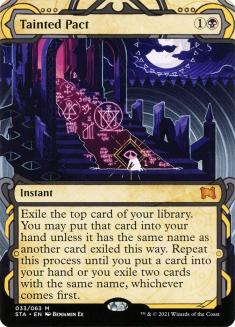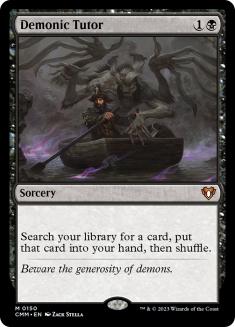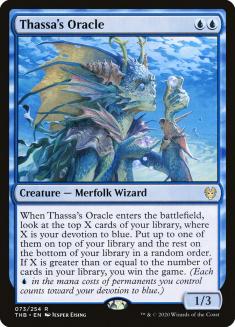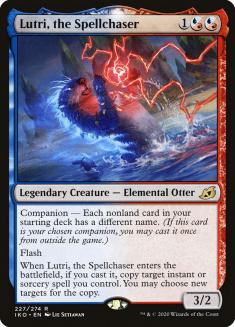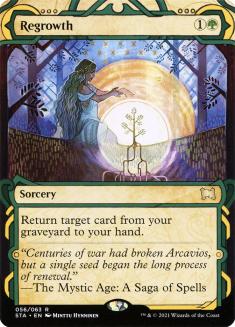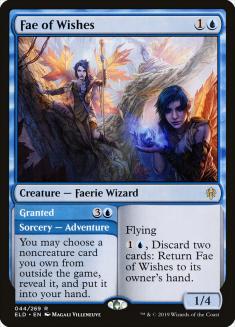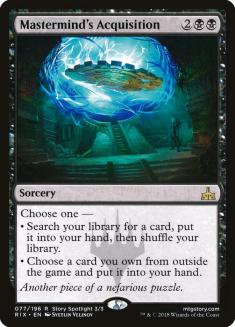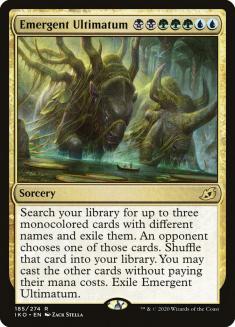While we still only know a little about Strixhaven proper, we have access to the entire Mystical Archive series. The Mystical Archive will only change the legality of cards in Historic, but for that format, it introduces a lot of cards we’ve seen before to an entirely new context, which should have interesting results. One card that caught my attention is a card that never really had the chance to shine in a competitive setting because its implied deckbuilding restrictions were too great. Tainted Pact is well known to cEDH players, and I think could have a place in Historic.
The modern design era and the large card pool available in Historic offer a wide range of cards for any particular role, allowing us to build singleton decks without sacrificing much card quality, and we get to pick up Lutri, the Spellchaser for our troubles.
So if you’ll trust that we can pull off a singleton deck without giving up too much, that still leaves the question of why you’d want to. Is Tainted Pact really strong enough to justify this?
At face value, Tainted Pact is an instant-speed Demonic Tutor in a singleton deck, as long as you don’t mind exiling half your library on average. The problem is that if you’re looking for a single card, it might be one of the last cards in your deck, and you might deck yourself if you’re committed to finding it. But if you’re just looking for any counterspell / any land / any removal spell, it can generally be cast for a trivial cost.
Okay, so it’s a pretty strong Impulse variant. But, again, is that really worth warping your entire deck to play a single copy of? No, absolutely not. We have bigger plans.
In a singleton deck, we can always choose to go all the way to the bottom of our library, so if we can assemble the combination of Thassa’s Oracle and Tainted Pact, we can cast Thassa’s Oracle and respond to the trigger by exiling our library to win the game. Ok, so now we’re getting somewhere, but that’s still a two-card combo when we only have one copy of each card in our deck. That’s a lot to ask for, but a two-card combo that wins the game for only four total mana that the opponent can’t interact with on the battlefield is incredibly strong.
But wait. It gets better.
About that companion we picked up for free for our troubles… it actually turns Tainted Pact into a one-card combo. Find Tainted Pact and put Lutri into your hand, then at the end of your opponent’s turn when you have five mana you can cast Tainted Pact and copy it with Lutri. With the first copy you dig until you find Thassa’s Oracle, and with the second copy you dig until the second card from the bottom of your library. Then untap, draw your last card, and cast Thassa’s Oracle.
The entire kill takes exactly two deck slots and costs 1BUU. Aside from that, you just have to play a singleton deck with Lutri as your companion. This is the tightest combo that has ever existed in terms of deckbuilding costs, which means you can basically do whatever you want with the rest of the deck.
Of course, this isn’t a package that you can slot into any deck — despite requiring very few specific cards, it still has a massive deckbuilding restriction, so it won’t slot smoothly into any existing decks. So what might a deck with this combo look like?
Creatures (2)
Planeswalkers (1)
Lands (26)
- 1 Swamp
- 1 Island
- 1 Lonely Sandbar
- 1 Snow-Covered Island
- 1 Snow-Covered Swamp
- 1 Overgrown Tomb
- 1 Watery Grave
- 1 Breeding Pool
- 1 Drowned Catacomb
- 1 Temple of Deceit
- 1 Radiant Fountain
- 1 Dismal Backwater
- 1 Fetid Pools
- 1 Field of Ruin
- 1 Blast Zone
- 1 Castle Vantress
- 1 Castle Locthwain
- 1 Fabled Passage
- 1 Zagoth Triome
- 1 Clearwater Pathway
- 1 Riverglide Pathway
- 1 Crawling Barrens
- 1 Barkchannel Pathway
- 1 Blightstep Pathway
- 1 Darkbore Pathway
- 1 Hengegate Pathway
Spells (31)
- 1 Brainstorm
- 1 Regrowth
- 1 Exclude
- 1 Memory Lapse
- 1 Mind Stone
- 1 Opt
- 1 Tainted Pact
- 1 Pact of Negation
- 1 Thoughtseize
- 1 Negate
- 1 Essence Scatter
- 1 Inquisition of Kozilek
- 1 Fatal Push
- 1 Censor
- 1 Hieroglyphic Illumination
- 1 Commit
- 1 Vraska's Contempt
- 1 Search for Azcanta
- 1 Cling to Dust
- 1 Eat to Extinction
- 1 Neutralize
- 1 Shark Typhoon
- 1 Extinction Event
- 1 Heartless Act
- 1 Eliminate
- 1 Sublime Epiphany
- 1 Jwari Disruption
- 1 Silundi Vision
- 1 Shadows' Verdict
- 1 Behold the Multiverse
- 1 Saw It Coming

This is a control deck first and foremost; it just happens to have a combo finish. The goal here is just to answer your opponent’s threats until you find the combo.
The basic shell is inspired by Andrew Cuneo’s successful Dimir Control deck from the Kaldheim Championship, but with redundant copies of cards swapped for close analogues and some trimmed to make room for a few discard and card selection spells to increase the chances of finding and resolving the combo.
The requirement to play singleton lands is substantially more restrictive than Lutri, the Spellchaser, but we have enough different land cycles in Historic that we can still cobble together a respectable manabase. This deck takes advantage of several cards from the Mystical Archive series, with Brainstorm, Memory Lapse, Inquisition of Kozilek, Blue Sun’s Zenith, Crux of Fate, and even a splashed Regrowth all making an appearance.
The Regrowth splash might look a little odd, but it’s a great way to get a little redundancy in a singleton deck, and a singleton deck will offer the widest variety of options to regrow, making it as powerful as possible, but most importantly, it allows us to get a second shot at Thassa’s Oracle or Tainted Pact if the opponent makes us discard or counters one of them.
This version is very much designed as control first, combo as an afterthought, not prioritizing ways to search to assemble the combo, but it does include Grim Tutor and Wishclaw Talisman in the sideboard in case you want to play as more of a combo deck in some matchups.
Creatures (5)
- 1 Fae of Wishes
- 1 Thassa's Oracle
- 1 Yasharn, Implacable Earth
- 1 Vorinclex, Monstrous Raider
- 1 Valki, God of Lies
Lands (25)
- 1 Forest
- 1 Swamp
- 1 Island
- 1 Snow-Covered Plains
- 1 Snow-Covered Island
- 1 Snow-Covered Forest
- 1 Snow-Covered Swamp
- 1 Overgrown Tomb
- 1 Watery Grave
- 1 Godless Shrine
- 1 Blood Crypt
- 1 Breeding Pool
- 1 Drowned Catacomb
- 1 Hinterland Harbor
- 1 Woodland Cemetery
- 1 Castle Vantress
- 1 Castle Locthwain
- 1 Fabled Passage
- 1 Zagoth Triome
- 1 Ketria Triome
- 1 Indatha Triome
- 1 Clearwater Pathway
- 1 Brightclimb Pathway
- 1 Barkchannel Pathway
- 1 Darkbore Pathway
Spells (30)
- 1 Brainstorm
- 1 Regrowth
- 1 Grim Tutor
- 1 Opt
- 1 Tainted Pact
- 1 Pact of Negation
- 1 Thoughtseize
- 1 Negate
- 1 Maelstrom Pulse
- 1 Explore
- 1 Inquisition of Kozilek
- 1 Cultivate
- 1 Fatal Push
- 1 Mastermind's Acquisition
- 1 Growth Spiral
- 1 Casualties of War
- 1 Legion's End
- 1 Wishclaw Talisman
- 1 Cling to Dust
- 1 Kiora Bests the Sea God
- 1 Agonizing Remorse
- 1 Elspeth's Nightmare
- 1 Extinction Event
- 1 Heartless Act
- 1 Emergent Ultimatum
- 1 Eliminate
- 1 Bala Ged Recovery
- 1 Shadows' Verdict
- 1 Binding the Old Gods
- 1 Alrund's Epiphany

This deck follows a tap-out plan instead, with a lot of cheap discard, removal, and tutors that can choose between going for the combo or just playing a more traditional Sultai Ramp / Emergent Ultimatum plan.
Fae of Wishes and Mastermind’s Acquisition give access to the sideboard in Game 1, which is convenient since the sideboard wants to be built as a wishboard anyway.
Emergent Ultimatum has a different mode in this deck from what we’ve typically seen: if there’s a single card you need, or that would win the game, you can search for that, Thassa’s Oracle, and Tainted Pact, and your opponent will have to give you the card you wanted rather than the lethal combo.
These are just two possible ways to build decks with the Tainted Pact combo, but I want to stress again how flexible the shell is, though it’s certainly hard to build a deck that can’t focus on a regular access to a particular card or combo without playing tutors.
I suspect that this combo is very strong, and will be very threatening to play against, but the deckbuilding cost is likely high enough that it won’t become oppressive, it’ll just be an interesting angle to explore, especially for players who like varied/singleton strategies or combo finishes.


